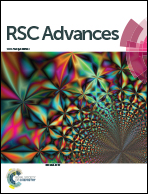Enhanced binding capacity of boronate affinity fibrous material for effective enrichment of nucleosides in urine samples†
Abstract
In this work, polyethyleneimine-modified boronate affinity fibrous cotton with good selectivity and higher binding capacity for cis-diols was developed for in-pipette-tip solid-phase extraction (SPE). The introduction of polyethyleneimine for the modification of cotton fiber provided abundant binding sites for adsorption of cis-diols, resulting in higher binding capacities up to 300 μg g−1 for catechol, 450 μg g−1 for dopamine and 700 μg g−1 for adenosine, respectively. The adsorbent could still show recognition ability towards cis-diols even with a 1000-fold amount of interferences in the solution. Several extraction parameters were optimized, including adsorbent dose, pipette times, washing and elution solvents. Under optimal extraction conditions, the proposed in-pipette-tip SPE method coupled with reversed-phase liquid chromatography was successfully used to extract nucleosides in urine. The limit of detection was 3.5–4.7 ng mL−1 and the recoveries were in the range of 89–102% with relative standard deviations of less than 9.9%. In conclusion, combination of the specific adsorption performance of the prepared boronate affinity fibrous material and in-pipette-tip SPE provided a fast pretreatment method of trace cis-diols in complex real samples.


 Please wait while we load your content...
Please wait while we load your content...